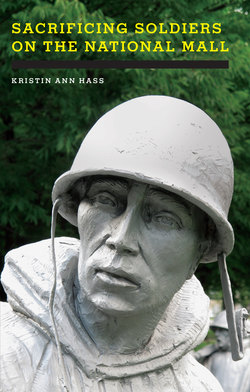Sacrificing Soldiers on the National Mall

Реклама. ООО «ЛитРес», ИНН: 7719571260.
Оглавление
Kristin Ann Hass. Sacrificing Soldiers on the National Mall
Отрывок из книги
Sacrificing Soldiers on the National Mall
on the National Mall
.....
Given that 5.7 million people served in the Korean War–era military, President Reagan had a good pool from which to form his committee. Reagan had disliked Maya Lin’s design for the Vietnam Memorial from the start. His secretary of the interior, James Watt, had threatened to delay groundbreaking for the memorial unless modifications were made to her design. The Frederick Hart sculpture of three Vietnam War era soldiers was a last-minute, controversial addition because Reagan and Watt insisted on the addition of heroic figures. In selecting veterans to serve on this board, Reagan had a chance to set the record straight on the Mall. Not surprisingly, the veterans he chose were not the kind of veterans who made up the membership of the Korean War Veterans Association (KWVA) but the highest ranking and highest achieving Korean War veterans. He appointed eleven men and one woman, including one African American and one Latino, four colonels and three generals, five CEOs (most notably, the CEO of Occidental International Corporation, a petroleum company with more than $22 billion in annual profits), and representatives of selected veterans organizations, including the KWVA.42 The board chair was General Richard Stilwell, a four-star general and the son of a four-star general who had earned his nickname, “Vinegar Joe,” through toughness and acidity.43 These folks were charged with building the memorial, but, like all memorials on the Mall, it would need the approval of the Commission of Fine Arts and the National Capital Planning Commission.
In response to the McMillan Plan for the Mall, the U.S. Commission of Fine Arts was established in 1910 by an act of Congress. The commission is charged with “giving expert advice to the President, Congress and the heads of departments and agencies of the Federal and District of Columbia governments on matters of design and aesthetics, as they affect the Federal interest and preserve the dignity of the nation’s capital.”44 The commission is composed of “well qualified judges of the fine arts” who are appointed by the president to a term of four years. Recent chairs of the commission include William Walton and J. Carter Brown, who served from 1971 to 2002. Brown, from the socially important—and once slave-trading—family that endowed Brown University, was among the most prominent forces in the American art world in the second half of the twentieth century. He served as the director of the National Gallery for twenty-three years, during which time he tripled its endowment and added the modern I. M. Pei addition. He also led the Commission of Fine Arts for more than thirty years, serving under seven presidents. Described as “America’s unofficial culture minister,” he had a great deal of influence in Washington. Brown was one of the strongest advocates for Maya Lin’s VVM design and, as such, had pushed for a particular, modern commemorative aesthetic on the Mall.
.....